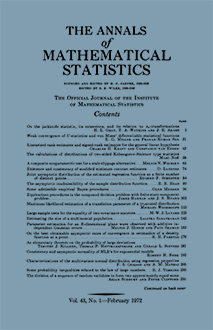Abstract
Let $W(t)$ denote a standard Wiener process for $0 \leqq t < \infty$. We compute the probability that $W(t) \geqq g(t)$ for some $t \geqq \tau > 0$ (or for some $t > 0$) for a certain class of functions $g(t)$, including functions which are $\sim (2t\log\log t)^{\frac{1}{2}}$ as $t\rightarrow\infty$. We also prove an invariance theorem which states that this probability is the limit as $m \rightarrow \infty$ of the probability that $S_n \geqq m^{\frac{1}{2}}g(n/m)$ for some $n \geqq \tau m$ (or for some $n \geqq 1)$, where $S_n$ is the $n$th partial sum of any sequence $x_1, x_2,\cdots$ of independent and identically distributed (i.i.d.) random variables with mean 0 and variance 1. The main results were announced in [19]. Some aspects of the invariance theorem were considered independently by Muller [14], who also studied the rate of convergence to the limiting distribution. Statistical applications of these ideas are indicated in [3] and [18]. In Section 2 we state the general theorems and give several examples. Sections 3-5 are devoted to the proof of these results. In Section 6 we indicate the applicability of our methods to stochastic processes other than the Wiener process. Of particular interest in this regard is the analogue of Theorem 1 for Bessel diffusion processes. Section 7 raises questions which will be treated in a subsequent paper.
Citation
Herbert Robbins. David Siegmund. "Boundary Crossing Probabilities for the Wiener Process and Sample Sums." Ann. Math. Statist. 41 (5) 1410 - 1429, October, 1970. https://doi.org/10.1214/aoms/1177696787
Information





